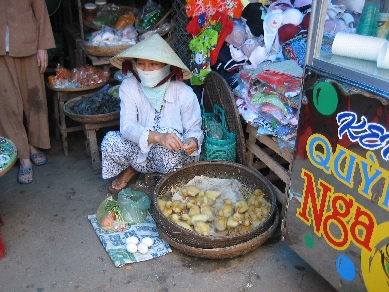Vietnam is “havin a laugh” as the Brits would put it!
One of the facts about the current Bird-Flu outbreaks in an increasing number of countries is so weird and dangerous, that if it were to be explained to the average man on the street, it would not be believed!
As per World Health Organisation approved rules, a country afflicted with the most infectious and virulent strain of the Bird-Flu virus, can declare it self “Free of Bird-Flu”, if no cases of the Bird-Flu appear for 21 successive days.
Think of South Africa, declaring itself “free of HIV” after 21 successive days without a new case of the AIDS!
What is more, a country can even declare one of it´s provinces “Free of Bird-Flu”, if there have been no fresh cases of the H5N1 for 21 days in that province.
It is like saying that even though I still have Malaria, I have had no problems with my right leg for a while now, therefore my right leg is free of Malaria!
This entire drama is played by the Governments of the effected countries, due to the pressure from the local tourism and the commercial sectors.
Obviously, a country which has it´s birds and even it´s people dropping dead from the Bird-Flu virus, is not the most desirable destination for the visitors from other countries.
Equally important is the fact that no country wants to import poultry, eggs and other related products from a Bird-Flu inflicted country.
As a case in point, today, the 10th of July 2007, Egypt banned all poultry imports from France and Germany after the potentially fatal H5N1 strain of bird flu was discovered in birds in those countries.
A ban of import of poultry from an infected country can have a devastating effect on it´s entire poultry industry and so the Government comes under tremendous pressure to declare the country free of the virus as quickly as possible.
There have been cases in authoritarian countries like China and Iran of total denial of the presence of the virus, even though various branches of the Government of each country had made statements to the contrary.
Other countries such as Indonesia, have made it extremely hard for the International press to obtain any information what so ever regarding the continuing outbreaks of the H5N1, in the Poultry, in other animals as well as in the humans.
It is almost a simple case of deception by the Governments of these countries.
They are trying to say to the world community, that their country is safe to visit and to import poultry and related products from.
At best this practice would expose the International community to unnecessary risk.
At worse, well……….
The most amazing part of this saga is the apparent acquiescence of the WHO in it´s approval of this dangerous practice.
The declaration today, from Vietnam (which has been declaring its Bird-Flu localities one after the other as the “regulation” 21 days period passes without an outbreak) would be funny, if it were not so very dangerous for us all.
Talking about Ninh Binh, one of its provinces infected with the Bird-Flu virus, the Veterinary Department stated, “It was regrettable for Ninh Binh when two new outbreaks occurred on July 9 just when the 21 day period was about to end”
Come off it Vietnam, you have got to be pulling our collective leg!
Here is a link to the news item from The Vietnam News Agency-
http://www.vnagency.com.vn/Home/EN/tabid/119/itemid/203723/Default.aspx
Filed under: 1918, Anti-viral, asymptomatic H5N1, Avian Flu, bio containment lab, Bird Flu, Bird Flu protection, Bird Market, Bird-Flu Map, Bird-Flu-Free, British, Burma, Central Java, Chickens, China, CIDRAP, Ducks, Eggs, Egypt, Fighting cocks, Flu Summit, France, Genetics, Germany, Guangdong, H5N1, H7N2, Health, Hollywood, Hong Kong, Human Bird Flu, Human-To-Human H5N1, India, Indonesia, Infection, Influenza, Jakarta, Japan, Malaysia, Masks, Mong Kok bird market, Myanmar, Ninh Binh, Pandemic, Politics, Poultry, Poultry Factory Farms, Sex, Singapore, Tamiflu, Turkey, Turkeys, UK, UNICEF, USA, vaccine, Vietnam, Virus, Water Birds, WHO | Leave a comment »









 The new, interactive map of the spread of the avian flu virus, (H5N1) for the first time incorporates genetic, geographic and evolutionary information that may help predict where the next outbreak of the virus is likely to occur.
The new, interactive map of the spread of the avian flu virus, (H5N1) for the first time incorporates genetic, geographic and evolutionary information that may help predict where the next outbreak of the virus is likely to occur.





